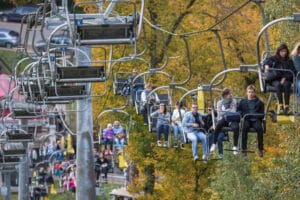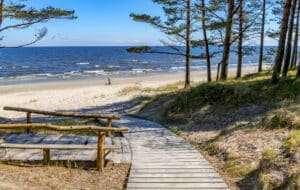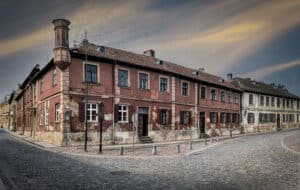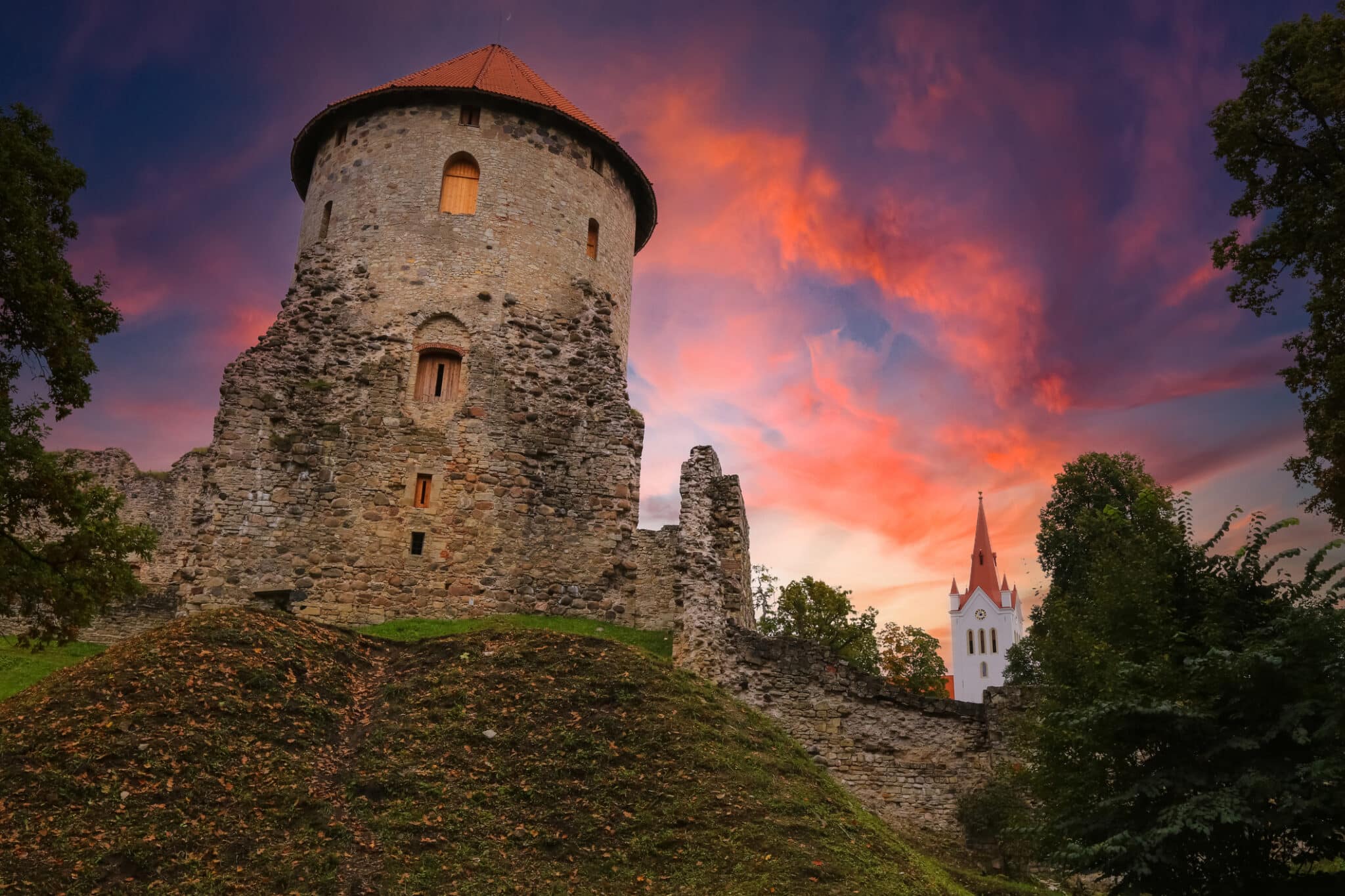Latvia is small country with a long history. Just outside the Riga lie a number of great sites to see – from sandy beaches to medieval castles and from majestic national parks to places literally straight out of fairy tales. See below for a small selection to get you started!
Cesis: A Medieval Town with a Castle at the Center
Cesis is a small town located approximately one hour northeast of Riga and best known for its medieval heritage.
The main attraction is its namesake, Cesis Castle, which was first built in the early 13th century by the Livonian Order as a fortress to protect the trade route between Riga and Tartu. Over the centuries, the castle was expanded and modified several times. During the Livonian War in the late 16th century, the castle was badly damaged and abandoned. In the 18th century, it was partially dismantled and turned into a granary. In the 19th century, it was used as a prison. Efforts to restore the castle in the early 20th century were undone by WWII, but in the 1960s the castle was finally fully restored.
The castle includes a tower, a great hall, a chapel, and a kitchen. The great hall, which was built in the 14th century, was once an important political center used for meeting and ceremonies and features a vaulted ceiling and a fireplace. The beautiful Gothic chapel, built in the 15th century has intricate carvings and other art worked into its walls.
The castle also has a museum that showcases the history of the Livonian Order and the castle itself. The museum displays artifacts such as weapons, armor, and household items, as well as interactive exhibits and multimedia displays.
The castle is surrounded by a well-preserved medieval city center known for its charming cobblestone streets and historic buildings including St. John’s Church, one of the oldest brick churches in Latvia, and the Old Pharmacy building, which is now a museum.
The streets also have plenty of atmospheric cafes to stop at and refresh yourself before heading back to Riga.
Sigulda and Gauja National Park
Sigulda is about an hour’s drive from Riga and known for its beautiful natural scenery, including Gauja National Park and the Turaida Castle.
Gauja National Park is the largest and oldest national park in Latvia. It offers many hiking and cycling trails through scenic forests, hills, and river valleys.

The park also includes several historic landmarks, such as the Turaida Castle, a medieval castle built in the early 13th century by the Livonian Brothers of the Sword, a Catholic military order. Heavily damaged during the Livonian War in the 16th century, it remained in ruins until its restoration in the 1950s. It now features a museum focused on medieval Latvian culture, lifestyle, and clothing.
Also inside Gauja National Park is the massive Gutmanis Cave. Visitors can take a boat tour of its impressive underground lake and see the unique rock formations there that have formed over thousands of years. The walls of the cave are covered in inscriptions and graffiti, some of which date back to the 17th century. According to legend, the medieval hero Gutmanis started the tradition when, hiding in the cave with his horse during a battle, he carved his name there using his sword.
Sigulda also features a bobsled and luge track, which was built for the 1986 World Championships and is still in use today. Visitors can take a ride on a bobsled or luge with a professional driver for an adrenaline-filled experience.
Sigulda has a charming town center with many cafes, restaurants, and shops selling locally made crafts and souvenirs. Visitors can also take a ride on the Sigulda Cable Car, which offers panoramic views of the Gauja River valley and the surrounding forests. The nearby seaside town of Saulkrasti has a long sandy beach and a popular summer music festival.
Jurmala: Seaside Resort
Jurmala is a seaside resort town on the Baltic Sea coast, just a half hour drive or train ride from Riga.
Jurmala’s rich history is reflected in its architecture, which features a unique blend of wooden villas and Art Nouveau buildings. Some of the most notable houses built in traditional Latvian wooden style include the Dubulti Lutheran Church and the House of Aspazija, which was once the home of the famous Latvian poet.

For a small town of only about 50,000 people, Jurmala also hosts a surprising number of cultural attractions such as the Jurmala City Museum and the Dzintari Concert Hall. Jomas Street is the main street and is lined with shops, restaurants, and cafes, many with outdoor seating in the warmer months.
The town has a rich history dating back to the 19th century, when it first became a popular destination for wealthy vacationers from nearby countries. Many of the grand, historic buildings that were constructed during this time still stand today, and are now protected as cultural heritage sites.
The town is also home to a variety of parks, forests, and nature reserves. Visitors can also enjoy a range of outdoor activities such as swimming, boating, hiking, and cycling.
Head to Jurmala to relax and unwind by the sea, soak up some history and culture, or explore Latvia’s stunning natural scenery.
Bauska
is a town of around 10,000 located near the border with Lithuania. About an hour and a half drive from Riga, it has a beautiful medieval castle, a museum, a nearby 18th century palace, and a park with walking trails.
One of the main tourist attractions is 15th century Bauska Castle, which was built by the Livonian Order. The castle was partially destroyed during the Livonian War in the 16th century and later renovated in the 19th century. Today, visitors can explore the castle ruins and the restored sections, including the tower, which offers stunning views of the surrounding area.
Another popular attraction in Bauska is the Rundāle Palace, which is located about 15 kilometers from the town center. The stunning baroque palace was designed by the prominent Italian architect Francesco Bartolomeo Rastrelli, who is also known for designing the Winter Palace in St. Petersburg, Russia. Rundale Palace is considered one of his finest works, with its ornate architecture and lavish interior decorations.
The palace is surrounded by extensive gardens with nearly 3km of trails, which are also designed in the baroque style. The gardens feature symmetrical parterres, fountains, and sculptures. During the 20th century, the palace served various purposes, including as a school, a granary, and a military hospital. After Latvia regained independence from the Soviet Union in 1991, extensive renovations were carried out to restore the palace and gardens to their former glory. Today, the palace also serves as a venue for concerts, exhibitions, and festivals.
Bauska, located on the banks of the Mūsa and Mēmele rivers, also offers numerous well-marked trails that cater to hikers of all skill levels. These include the Bauska Castle Hill Nature Trail, which runs by castle, river, and through the town. The trail is around 5km long and takes about 1-2 hours to complete. Kemeru Bog Boardwalk Trail starts about a 30 minute drive from Bauska and takes you through the Kemeru bog, which is a unique ecosystem of wetlands, forests, and ponds. The trail is around 3km long and takes about 1-2 hours to complete.
Kuldiga
Kuldiga is a charming small town about two and half hours from Riga.

Kuldiga is home to the widest waterfall in Europe, the Venta Waterfall, which is 249 meters wide and 1.8 meters high. Visitors can cross the waterfall on a historic brick bridge and watch salmon jump over the falls during the fish migration season.
The old town of Kuldiga is one of the best-preserved medieval towns in Latvia, with narrow cobblestone streets and beautifully restored buildings from the 17th and 18th centuries. The town is also known for its distinctive red roofs, which give it a unique and picturesque look.
Kuldiga is famous for its annual Kuldiga Airshow, which takes place in August and attracts aviation enthusiasts from all over Latvia and beyond. The airshow features acrobatic displays, vintage aircraft, and other aerial performances.
The town is also home to several cultural institutions, including the Kuldiga Art House and the Kuldiga District Museum. The museum showcases the history and culture of the region, with exhibitions on local folklore, traditional crafts, and more.
Kuldiga is surrounded by beautiful natural scenery, including the Riezupe Sand Caves, once a quartz mine but now a tourist attraction with miles of underground passages to explore.


